If you’re tired of questioning what’s lurking in your tap water and are looking for a reliable, comprehensive solution, then I need to tell you about my experience.
After months of research and living with the results, I can honestly say you should buy a Puragain water system.
It’s more than just a filter; it’s a complete change in how you experience water in your home. It has genuinely transformed my daily life, from the water I drink to the way my skin and hair feel.
This isn’t just another kitchen gadget; it’s an investment in your well-being.
My Journey With Puragain Water
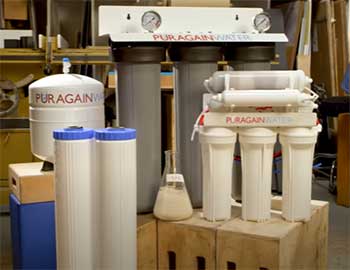
I have to admit, I used to be one of those people who thought, “water is water.”
I lived in an area with municipally treated water, and I figured that was good enough.
I’d occasionally buy bottled water if I was out, but at home, the tap was my go-to.
The subtle chlorine smell?
I just thought that’s what clean water smelled like. The limescale buildup on my kettle and showerhead? I chalked it up to normal wear and tear. It wasn’t until a friend visited and wrinkled her nose after taking a sip from my tap that I started to second-guess things.
She mentioned how “hard” and chemical-tasting my water was compared to her filtered water at home. That little comment planted a seed of doubt that started to grow.
My research journey began. I started noticing things I’d previously ignored. My coffee never tasted quite as rich as it did at my favorite cafe. My skin often felt tight and dry after a shower, no matter what moisturizing body wash I used.
My glassware always had a cloudy film, even right after coming out of the dishwasher. These weren’t huge problems on their own, but together, they painted a picture of water quality that was far from ideal. So, I decided it was time for a change.
I looked into pitcher filters, faucet attachments, and finally, whole-house water filtration systems. That’s when I stumbled upon Puragain. What intrigued me was their comprehensive approach—not just filtering drinking water, but treating all the water entering my home. The initial consultation was incredibly enlightening.
A technician came out, tested my water right in front of me, and explained what all the numbers meant. Seeing the levels of chlorine, hardness, and other dissolved solids was genuinely shocking. It was the proof I needed. I made the decision and had the Puragain system installed. The difference wasn’t just noticeable; it was staggering, and it began the very first day.
The Undeniable Pros of a Puragain System
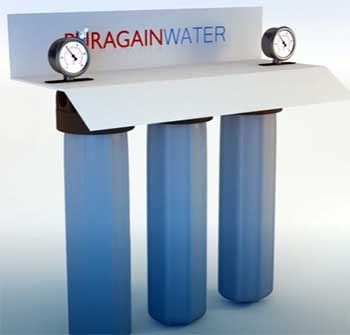
When you invest in something like a whole-house water system, you’re hoping for a noticeable improvement.
With Puragain, the improvements weren’t just noticeable; they were life-altering in small, cumulative ways that have made a massive difference.
Let’s talk about the tangible benefits I’ve experienced firsthand, because they go far beyond just a better glass of water.
First and foremost, the taste and smell are on another level. I used to think I didn’t like drinking plain water.
It turns out, I just didn’t like drinking my tap water. The water from my Puragain system is crisp, clean, and utterly refreshing.
There’s zero hint of chlorine or any of that earthy, metallic background taste I had become accustomed to. It’s just pure hydration. This has had a ripple effect—I drink significantly more water throughout the day now, which has boosted my energy levels and overall sense of well-being.
My morning coffee and tea are now bursting with flavor. I can taste the actual coffee beans and tea leaves, not the impurities in the water. Even simple things, like boiling pasta or washing vegetables, feel cleaner. You’re not introducing unwanted minerals and chemicals into your food.
The benefits for my skin and hair have been equally dramatic. Before the system was installed, I was in a constant battle with dry, itchy skin, especially during the colder months. My scalp was often flaky, and my hair felt brittle and looked dull.
I was spending a small fortune on deep conditioners, clarifying shampoos, and heavy moisturizing lotions. Within a week of showering in Puragain-treated water, I felt a difference. The tight, stripped feeling on my skin after a shower was gone. My skin felt softer and more hydrated. My hair became more manageable, shinier, and held its style better.
Why?
Because the system removes the hard minerals like calcium and magnesium that cause soap scum and leave residue on your body. Your soap and shampoo can actually do their job properly, lathering up beautifully and rinsing away completely. I’m using about half the amount of soap, shampoo, and conditioner I used to, which is an unexpected but welcome financial saving.
Then there’s the impact on my home itself. The war against limescale is over, and I have won. My shower doors, which I used to have to squeegee religiously and still scrub with harsh chemicals, stay sparkling clean.
My faucets and showerheads are free of that crusty white buildup. The inside of my kettle is as shiny as the day I bought it. My dishwasher is finally cleaning my glasses properly, leaving them crystal clear without any cloudy film. This isn’t just a cosmetic benefit.
That same scale buildup was happening inside my appliances—the dishwasher, the washing machine, the water heater. By eliminating it, the Puragain system is extending the lifespan and improving the efficiency of these expensive appliances.
They work less hard, use less energy, and are less likely to break down prematurely. It’s a peace-of-mind benefit that’s hard to put a price on.
A Look at The Potential Cons of Puragain Water

As much as I rave about my Puragain system, it’s only fair to give you a complete picture. No product is perfect for everyone, and there are a few considerations you should be aware of before making the investment.
It’s about being prepared and making sure it’s the right fit for your home and lifestyle.
- The Initial Financial Outlay
Let’s be direct: this is not an impulse buy. A whole-house Puragain system is a significant upfront investment. It’s considerably more expensive than buying a water pitcher or a faucet-mounted filter.
When the representative gave me the quote, I definitely had to take a moment to process it. You are paying for a premium, comprehensive solution that treats every drop of water in your home, and the price reflects that.
For some households, this initial cost can be a major hurdle. You have to view it as a long-term investment in your home’s infrastructure and your family’s health, similar to upgrading your HVAC system or replacing your roof.
If your budget is tight, this initial expense might be a deal-breaker, and that’s a perfectly valid reason to consider other, less comprehensive options first.
- The Physical Space Requirement
These systems aren’t tiny. The main filtration tanks and, if you opt for it, the water softener, require a dedicated space. Typically, this is in a garage, basement, or a utility closet near where your water main enters the house.
In my case, I had a perfect spot in my garage, but I know that’s not the reality for everyone. If you live in a small apartment, a condo, or a house with very limited utility space, finding a suitable location for the installation could be a real challenge.
You need to measure your available space carefully and discuss the installation logistics with the technician during the consultation to ensure it’s even feasible. You can’t just tuck it under the sink; it’s a permanent installation that needs to be planned for.
- The Feeling of “Slippery” Water
This was one of the oddest things to get used to, and it’s a direct result of the water softening process. Soft water feels different. When you wash your hands or shower, the water can feel slick or slippery.
The first few times, I kept rinsing my hands, thinking I hadn’t gotten all the soap off. It’s a strange sensation. The reality is, you’re feeling your own clean skin, free from soap scum residue for the first time. Hard water leaves a film of precipitated soap on your skin, which we often mistake for “squeaky clean.”
The slippery feeling is the absence of that residue. While I’ve completely adapted to it now and actually prefer it, I’ve had guests comment on it. It’s a sensory adjustment, and for some people, it can be an initial turn-off until they understand what’s causing it.
Simple Maintenance For Long-Lasting Performance
One of the best things about the Puragain system is that it’s surprisingly low-maintenance. Once it’s installed, it largely takes care of itself.
However, a little bit of regular attention will ensure it continues to operate at peak efficiency for years to come, protecting your investment and guaranteeing you always have the best quality water.
Think of it like a car; you don’t have to be a mechanic, but you do need to put in gas and get the oil changed. Here are the simple tips I follow to keep my system running perfectly.
- Keeping the Salt Topped Up
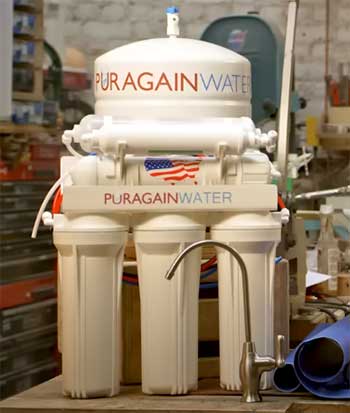
If you have the water softener component, as I do, this will be your most frequent—and most important—task.
The water softener uses a process called ion exchange, and it needs salt to regenerate the resin beads that capture the hardness minerals.
This sounds complicated, but your role is simple: just keep the salt tank (also called the brine tank) filled with the right kind of salt pellets.
The system regenerates automatically based on your water usage, so you don’t have to worry about scheduling it. You just need to provide the fuel.
I check my salt level about once a month. I simply lift the lid on the brine tank and take a look. As a rule of thumb, I always make sure the salt level is above the water level inside. When it gets low, I just pour in a new bag of salt pellets, which I can buy at any major hardware store.
The system itself is incredibly efficient, so a single bag lasts a surprisingly long time. It’s a five-minute task that ensures my skin stays soft and my appliances stay scale-free. Don’t let it run out completely, as that will allow hard water back into your home until the system can regenerate again.
- The Occasional Filter Change
Depending on the exact model you get, your whole-house system will have one or more pre-filters or post-filters. These are typically sediment filters designed to catch larger particles like sand, silt, and rust before they reach the main filtration media or your faucets.
These filters are sacrificial; they do the dirty work to protect the more expensive and long-lasting components of your system. My system has a sediment pre-filter that needs to be changed approximately every 6 to 12 months.
This is another really straightforward job. Puragain showed me how to do it during the installation, and it involves turning off the water supply to the filter, unscrewing the filter housing with a special wrench they provided, swapping the old, dirty cartridge for a new one, and screwing it back on.
The first time I did it, I was a bit nervous, but it took less than 15 minutes. Seeing how discolored the old filter was is always a satisfying reminder of all the gunk that is no longer flowing through my pipes.
Your specific filter change schedule will depend on the quality of your incoming water, so it’s a good idea to check it after six months and see how it looks.
- Annual Professional Check-up
While I can handle the salt and the basic filter changes, I still believe in the value of a professional eye. I have Puragain come out for an annual service check. This isn’t strictly required, but it gives me immense peace of mind.
During this service, the technician does a comprehensive check of the entire system. They test the water again to ensure it’s meeting the specified purity levels. They check the softener’s regeneration cycle settings and make sure the control valve is functioning perfectly.
They’ll also inspect all the connections for any potential leaks and clean out the brine tank if necessary to prevent any salt bridging issues. This professional tune-up ensures everything is running as efficiently as possible, potentially catching a small issue before it becomes a big problem and extending the overall life of the system.
For me, the small annual service fee is well worth knowing my significant investment is being properly maintained and protected.
Comparing Puragain To The Competition
When I was doing my research, I didn’t just look at Puragain. I spent weeks comparing specifications, reading user feedback, and trying to understand the core differences between the major players.
It’s crucial to see how Puragain stacks up against other well-regarded brands like APEC, Leaf, and Kinetico. Each has its own philosophy and technology, and what’s best for me might not be best for you.
- Puragain’s Approach Versus APEC Water Systems
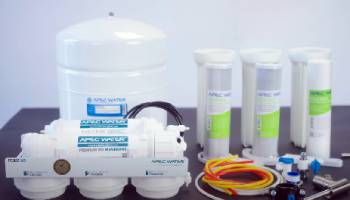
APEC Water Systems is a name you’ll see frequently, and for good reason.
They are very well-known, particularly for their under-sink reverse osmosis (RO) systems.
When I looked at APEC, their main strength seemed to be in providing extremely high-purity drinking water at a single point of use.
Their RO systems are fantastic for the kitchen sink, delivering water that is stripped of almost everything. However, that was also its limitation from my perspective. I wanted a whole-home solution. While APEC does offer whole-house systems, their brand identity feels more centered around point-of-use filtration.
The problem I wanted to solve wasn’t just my drinking water; it was the hard water damaging my appliances and the chlorinated water I was showering in. An APEC under-sink system wouldn’t have helped my dry skin, my spotty glassware, or the scale buildup in my water heater.
To get a comparable whole-house solution from APEC, I would have had to piece together a separate carbon filter, a water softener, and perhaps an additional UV filter. It felt less like an integrated system and more like a collection of components.
Puragain, on the other hand, presented me with a single, streamlined system designed from the ground up to work together to solve all my water problems at once. The consultation and installation process with Puragain felt more holistic and tailored to my specific water test results.
- Puragain’s Technology Versus Leaf Water Systems
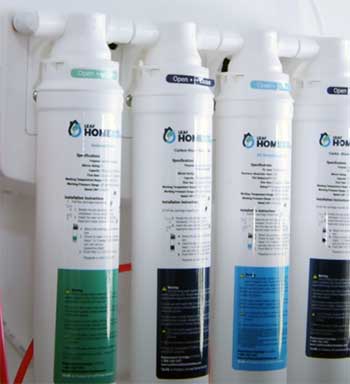
Leaf Water Systems caught my eye because of their focus on sustainability and their unique filtration media.
They emphasize not using salt or chemicals and position themselves as an eco-friendly choice.
Their systems often use different catalytic media to condition the water rather than soften it in the traditional, ion-exchange way.
This means they are designed to prevent scale from sticking to surfaces rather than removing the hardness minerals (calcium and magnesium) entirely.
For me, this was a key difference. While preventing scale is great, I wanted those minerals gone. I wanted the benefits of true soft water: better lathering with soap, softer skin and hair, and no mineral residue at all.
The Leaf system seemed like a good compromise for someone strictly opposed to salt-based softeners, but it wasn’t the complete removal I was looking for. Furthermore, the Puragain system I chose is a multi-stage process. It’s not just a softener or just a conditioner; it includes activated carbon filtration to remove chlorine, sediment filters for particulates, and the water softener for the hardness.
It felt like a more robust, multi-pronged attack on water quality issues. The comprehensive nature of the Puragain system ultimately felt more reassuring than the scale-prevention focus of the Leaf system.
- Puragain’s Service Model Versus Kinetico Water Systems
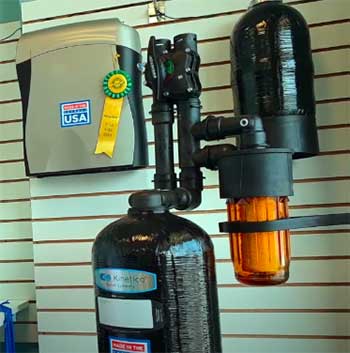
Kinetico is a giant in the industry, and their key selling point is their non-electric, dual-tank systems that run on the kinetic energy of moving water.
This is, without a doubt, a brilliant piece of engineering. The idea of a system that provides soft water 24/7 without ever needing electricity is very appealing.
No timers to set, no computers to fail. I was seriously considering a Kinetico system. However, two things gave me pause.
First, the proprietary nature of their systems. Kinetico systems can generally only be serviced by Kinetico dealers, and the parts are specific to their brand.
This can sometimes lead to higher repair costs down the line and a lack of options if you’re unhappy with your local dealer’s service. Second, the complexity. While elegant, the mechanics are intricate. I found the Puragain system to be more straightforward in its design, using industry-standard-sized tanks and valves, which I felt might offer more flexibility for service in the distant future.
The other major factor was the initial consultation. Kinetico systems are sold exclusively through dealers, and the sales process can be very high-pressure depending on your local representative. My experience with the Puragain consultation was more educational and less like a hard sell.
They tested my water, explained the results, and laid out the options clearly. That customer-focused approach built a level of trust that was a significant factor in my final decision.
Frequently Asked Questions (FAQ)
The cost of a Puragain water system can vary quite a bit because it’s not a one-size-fits-all product. The final price depends on several factors: the specific water problems you have (e.g., just hardness, or chlorine, iron, and sediment), the size of your home and family (which determines the capacity of the system you’ll need), and which specific components you choose (e.g., a whole-house filter, a water softener, a reverse osmosis drinking water system, or a combination). Based on my research and experience, you can expect the investment for a comprehensive whole-house system to be in the range of several thousand dollars. The best way to get an accurate number is to take advantage of their free in-home water test and consultation.
This is a point of frequent confusion. “Puragain” and “PUR” are two completely different companies. PUR is a well-known brand, owned by Helen of Troy Limited, that primarily manufactures water pitcher filters, faucet-mounted filters, and refrigerator filters. Yes, PUR filters do work for what they are designed to do—they are certified to reduce contaminants like chlorine, lead, and mercury from drinking water at a single point of use. However, they are not whole-house systems and do not address issues like water hardness (limescale). My article is about Puragain, which provides comprehensive, whole-house treatment solutions.
The main downsides of water purifiers generally fall into a few categories. First is the cost, which includes the initial purchase price and ongoing maintenance like filter replacements or salt for softeners. Second is maintenance itself; if you don’t maintain them properly, their effectiveness drops, or they can even become a source of contamination. Third, some types of purifiers, like reverse osmosis systems, strip virtually everything from the water, including potentially beneficial minerals like calcium and magnesium. This can affect the taste for some people. Lastly, whole-house systems require physical space for installation, which can be a problem in smaller homes or apartments.
Based on my research during my purchase process, Puragain Water is a privately held company. It appears to operate as a direct-to-consumer business, focusing on in-home consultations, customized system recommendations based on water testing, and professional installation. Unlike brands like PUR (owned by Helen of Troy) or Aquasana (owned by A. O. Smith), it does not seem to be a subsidiary of a large, publicly-traded corporation, which often allows them to have a more direct and focused relationship with their customers.
The Final Verdict: An Investment I’d Make Again
Looking back, the decision to install a Puragain water system was one of the best I’ve made for my home and my health. The difference is so profound that I can’t imagine going back to untreated tap water.
From the pure, delicious taste of the water I drink to the tangible benefits for my skin, hair, and even my household appliances, the value is undeniable. If you are on the fence, I urge you to at least get your water tested.
Seeing the results for yourself might be all the convincing you need. This is a worthwhile purchase.
